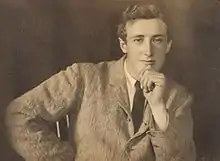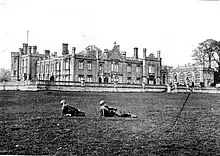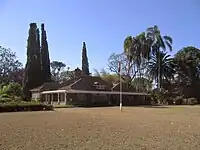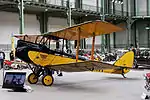Denys Finch Hatton | |
|---|---|
 | |
| Born | Denys George Finch Hatton 24 April 1887 Kensington, London, England |
| Died | 14 May 1931 (aged 44) |
| Education | Eton College |
| Alma mater | Brasenose College, Oxford |
| Parent(s) | Henry Finch-Hatton, 13th Earl of Winchilsea Anne Jane Codrington |
| Military service | |
| Allegiance | |
| Service/ | |
| Rank | Lieutenant |
| Unit | East African Mounted Rifles |
| Battles/wars | First World War |
| Awards | Military Cross |
Denys George Finch Hatton MC (24 April 1887 – 14 May 1931) was a British aristocratic big-game hunter and the lover of Baroness Karen Blixen (also known by her pen name, Isak Dinesen), a Danish noblewoman who wrote about him in her autobiographical book Out of Africa, first published in 1937. In the book, his name is hyphenated: "Finch-Hatton".
Early life
Denys was born in Prince of Wales Terrace, Kensington on 24 April 1887.[1][2] Finch Hatton was the second son and third child of Henry Finch-Hatton, 13th Earl of Winchilsea and his wife, the former Anne Codrington, daughter of Admiral of the Fleet Sir Henry Codrington.
He was born into an old aristocratic Finch family. His grandfather was George Finch-Hatton, 10th Earl of Winchilsea, whose mother was Lady Elizabeth Murray, cousin of Dido Belle and daughter of 2nd Earl of Mansfield. Denys was also descended from Jane Austen's rich brother Edward Austen Knight through his grandmother Fanny Margaret Rice, who herself was the daughter of Elizabeth Austen Knight and Edward Rice, Fanny was the wife of the 10th Earl of Winchilsea.

By the 1860s, his half uncle the 11th Earl of Winchilsea had gambled away the family's several fortunes,[1] and was forced to leave the ancestral seat Eastwell Park, which at the time of Denys's birth was already tenanted to Prince Alfred, second son of Queen Victoria, and his wife Maria Alexandrovna of Russia. This was also the house where Denys's father was born. As the Eastwell estate was let go, Denys's father Henry and his older brother Murray was brought up by their mother Fanny, dowager Countess of Winchilsea quietly at Haverholme Priory, another country house inherited by the 10th Earl in 1831 from a childless aunt and uncle in law, the 10th Earl left Haverholme Estate to his second born son Murray (later the 12th Earl), another uncle of Denys.[3]
Denys’s early years were spent in Haverholme Priory with his cousins and uncle, but his family resided in the nearby Haverholme Dower House, when his father inherited the title from his older brother in 1898 and became the 13th Earl, Denys and his siblings were relocated to Haverholme Priory.[3][4] He was educated at Eton and Brasenose College, Oxford. At Eton, he was successful at athletics, served as secretary of the music society, and earned a degree in Modern History.[5]
Denys enjoyed popularity at Eton, one of his admirers was the flamboyant and fabulously wealthy, Philip Sassoon (his only sister was Marchioness of Cholmondeley). Denys had previously protected Sassoon from being bullied for his feminine behavior. In turn, Sassoon visited sick Denys and gifted him ruby shirt studs and diamond cuff links, peeved by the vulgar opulence, Denys threw them away to the unlit grate, but decided to retrieve it to give it to his sister Gladys.[6]
Africa


In 1910, after a trip to South Africa, Finch Hatton travelled to British East Africa and bought some land on the western side of the Great Rift Valley near what is now Eldoret. He turned over the investment to a partner and spent his time hunting. In Kenya, Finch Hatton was a close friend of the Hon. Reginald Berkeley Cole (1882–1925), an Anglo–Irish aristocrat, born into a prominent Ulster family, who had also settled in the colony. Cole was very well connected in Kenya, being the brother-in-law of Hugh Cholmondeley, 3rd Baron Delamere, the effective leader of the White settlers in the country.
In June 1910, Denys's older brother Guy Montagu (then Viscount Maidstone) snatched up and married the wealthiest American heiress of the season, Margaretta Armstrong Drexel, daughter of banking magnate Anthony Joseph Drexel Jr. They were married at 22 Grosvenor Square attended by 1500 guests, Denys attended the wedding but declined to be his best man.[6]
In September 1914, Finch Hatton was commissioned as a temporary lieutenant during the First World War, attached to the East African Protectorate forces fighting in the East African campaign.[7] He served with his friend Berkeley Cole, a former officer in the 9th Lancers and a temporary captain in command of an eponymous irregular force known as Cole's Scouts. The irregular unit was made up of Somali soldiers and regular British soldiers from the 2nd Battalion Loyal Regiment (North Lancashire).[8][9] After this unit was disbanded, Finch Hatton was given a staff appointment as aide-de-camp to General Hoskins.[10] On the 1st February 1917, he was awarded the Military Cross.[11]
In Channel 4's Edward VIII: The Lion King, it was revealed that in 1928 and 1930, Finch Hatton played host to the Prince of Wales, later Edward VIII, in a safari that switched from hunting to photography. This relationship led to Edward VIII's taking up Finch Hatton's causes, such as abandoning the use of cars for hunting safaris, and shifting towards filming big game, wildlife photography, and the founding of the Serengeti National Park.
Relationship with Blixen

Finch Hatton was not known to have had any serious romances before he met Baroness Blixen. They were introduced at the Muthaiga Club on 5 April 1918. Soon afterwards he was assigned to military service in Egypt. On his return to Kenya after the Armistice, he developed a close friendship with Blixen and her Swedish husband, Baron Bror von Blixen-Finecke. He left Africa again in 1920 but returned in 1922, investing in a land development company.
By this time, Karen Blixen had separated from her husband, and after their divorce in 1925, Finch Hatton moved into her house and began leading safaris for wealthy sportsmen. Among his clients were Marshall Field Jr and Edward, Prince of Wales.
According to a highly sympathetic biography of Beryl Markham by author Mary S. Lovell, in 1930 Finch Hatton succumbed to a love affair with Markham, who was working as a race-horse trainer in Nairobi and the surrounding area. Markham had had a series of lovers, both single and married, and she had apparently had an attraction to Finch Hatton for years, but had not acted on it while Blixen, who gave Markham shelter and support over the years, was most deeply involved with Finch Hatton. During this period, however, he was also still seeing Blixen. Later, Markham became known as a pioneer flyer herself; Markham attributed her interest in flying to her association with Tom Campbell Black.[12]
Death

On the morning of 14 May 1931, Finch Hatton's Gipsy Moth took off from Voi Airport, circled the airport twice, then plunged to the ground and burst into flames. Finch Hatton and his Kĩkũyũ servant Kamau were killed. His final flight is recounted by fellow pilot Markham in her memoir West with the Night.
In accordance with his wishes, Finch Hatton was buried in the Ngong Hills, some five miles (8 km) to the west of the present-day Nairobi National Park. Karen Blixen had chosen the site. "There was a place in the hills, on the first ridge in the Game Reserve that I myself, at the time I thought that I was to live and die in Africa, had pointed out to Denys as my future burial-place. In the evening while we looked at the hills from my home, he remarked that then he would like to be buried there himself as well. Since then, sometimes when we drove out in the hills, Denys had said; 'Let us drive as far as our graves'."[13] Later, his brother erected an obelisk at the gravesite upon which he placed a simple brass plaque inscribed with Finch Hatton's name, the dates of his birth and death and an extract from Samuel Taylor Coleridge's narrative poem the Rime of the Ancient Mariner: "He prayeth well, who loveth well both man and bird and beast". The co-ordinates of the gravesite are: 1°24′48″S 36°39′45″E / 1.4134°S 36.6626°E.
A footbridge at Eton is inscribed with the words "Famous in these fields and by his many friends greatly beloved. Denys Finch Hatton 1900–1906".[14] The dates refer to his attendance at Eton.
Fictional portrayals
Finch Hatton was portrayed by Robert Redford in the 1985 film Out of Africa.
He was portrayed by Trevor Eve in the 1988 miniseries Beryl Markham: A Shadow on the Sun.
See also
Footnotes
- 1 2 "LibraryAware First Chapter". libraryaware.com. Retrieved 22 April 2023.
- ↑ "Index entry". FreeBMD. ONS. Retrieved 22 February 2018.
- 1 2 "NOSTALGIA – Sleaford Museum returns to Haverholme Priory for a tale which made a movie – the story of Denys Finch Hatton".
- ↑ "Ewerby". www.slha.org.uk. Retrieved 22 April 2023.
- ↑ "London Art and Food ~". London Art and Food. Retrieved 22 April 2023.
- 1 2 Wheeler, Sara (2009). Too close to the sun : the audacious life and times of Denys Finch Hatton. Internet Archive. New York : Random House Trade Paperbacks. ISBN 978-0-8129-6892-7.
- ↑ "Page 12669 | Supplement 29408, 17 December 1915 | London Gazette | The Gazette". www.thegazette.co.uk. Retrieved 17 November 2022.
- ↑ Hordern, Charles, Lieutenant-Colonel (1941). Military Operations East Africa, August 1914 – September 1916. Battery Press.
{{cite book}}: CS1 maint: multiple names: authors list (link) - ↑ Lord Cranworth (1939). Kenya Chronicles. Macmillan.
- ↑ "Page 4529 | Supplement 29571, 5 May 1916 | London Gazette | The Gazette". www.thegazette.co.uk. Retrieved 17 November 2022.
- ↑ "Page 292 | Issue 13048, 6 February 1917 | Edinburgh Gazette | The Gazette". www.thegazette.co.uk. Retrieved 17 November 2022.
- ↑ Markham, Beryl (1983). West with the Night (First ed.). San Francisco. ISBN 9780865471184. OCLC 9642470.
{{cite book}}: CS1 maint: location missing publisher (link) - ↑ Blixen, Karen (1985). Out of Africa and Shadows on the Grass. Harmondsworth, England: Penguin Books Ltd. p. 248.
- ↑ Some photos of this bridge can be found at: https://sites.google.com/view/denysfinchhattonbridge/home
References
- Too Close to the Sun: The Life and Times of Denys Finch Hatton (2006) by Sara Wheeler
- Out of Isak Dinesen (1998) by Linda G. Donelson
- The Eton College Chronicle (21 May 1931)
- Silence Will Speak (1977) by Errol Trzebinski
- The Lives of Beryl Markham (1993) by Errol Trzebinski
- Out of Africa (1937) by Isak Dinesen (Pseudonym of Karen Blixen)